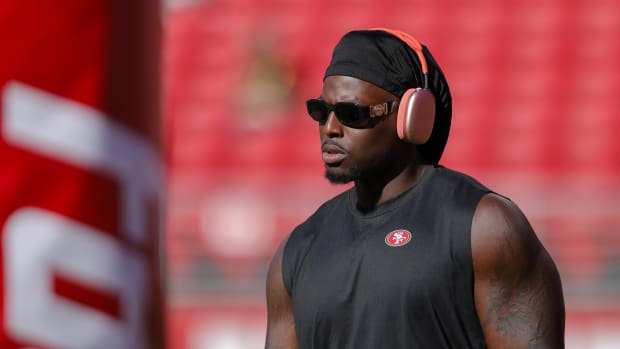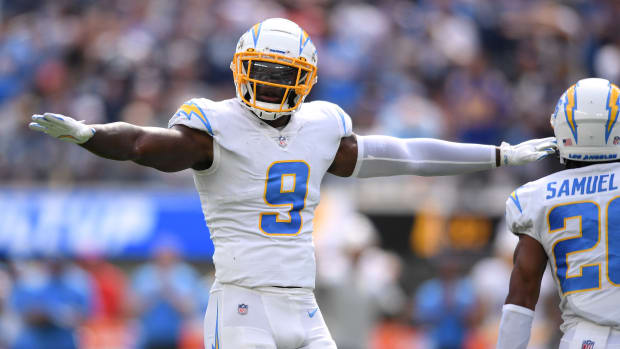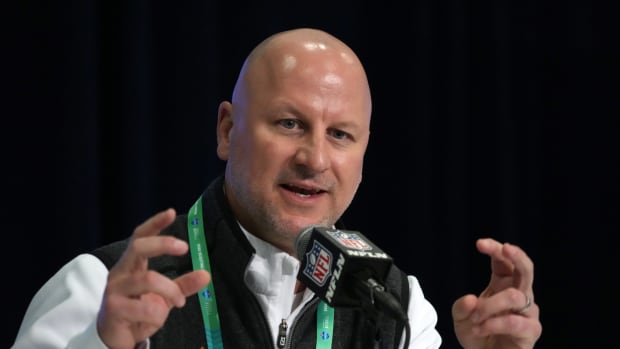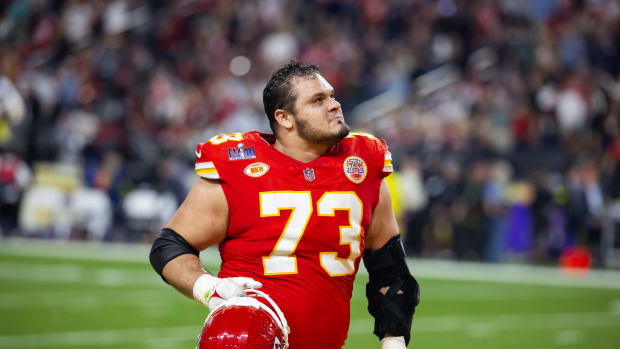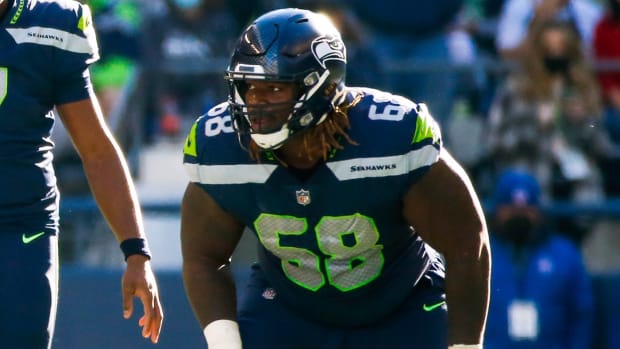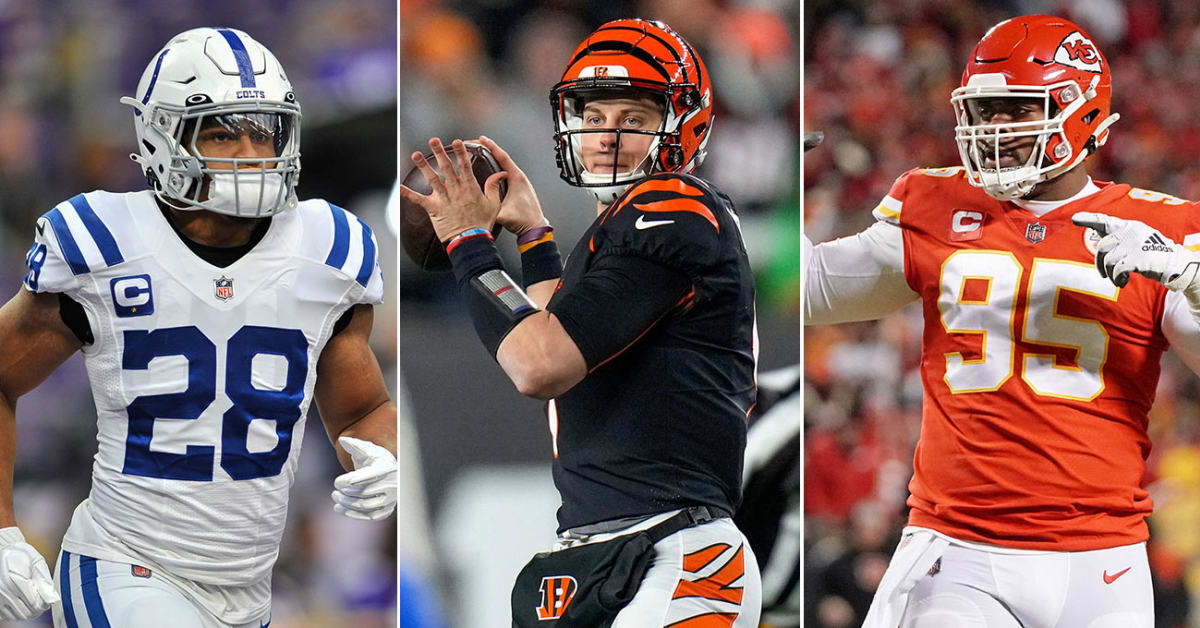
Jonathan Taylor, Joe Burrow, Chris Jones Have Offseason Business Left to Resolve
The long and cold NFL offseason, the seven-month grind that is the longest time between (real) games of any major professional sport, is finally over. But as the season approaches, a few vestiges of the offseason remain.
I have always referred to the offseason as “me time” in sports, when players are concerned about their situations, their contracts and what’s best for them. Come September, however, it is “we time,” when everything is about the team and what’s best for the collective.
There are a couple of situations that stand out as still not yet “we time” as the season begins. Let’s examine.

Jeffrey Becker/USA TODAY Sports (Taylor); Denny Medley/USA TODAY Sports (Chiefs); Sam Greene/The Enquirer/USA TODAY Network (Burrow)
Taylor’s trials
One of the offseason cases of running back dystopia did not resolve this week as expected, and may not subside for quite a while. Jonathan Taylor saw what was happening with the stagnant market at this position and decided to push the contract envelope while still young and worthy of top-of-market pay. The team, consistent with many others this offseason, had other ideas, and the relationship has soured. Taylor sought and received permission to try to find a new home, but none was found due to either (1) the Colts’ asking for too much draft or player compensation back, and/or (2) Taylor asking for too much in a contract that was being negotiated simultaneously with the trade compensation.
Taylor has value, but part of that value is his rookie contract, still existing with one more year on it. He certainly wants a long-term contract at the top of the market, although any acquiring team may just want him this year with a franchise tag available next year. For running backs, that seems to be the way that teams are going now: Running backs are indeed valuable, but only valuable on their first contracts. Therein lies the rub.
We have seen a clear pattern this offseason: Running back contract discontent met with indifference. Austin Ekeler made noise about a new contract and/or a new home; he was given only some contract incentives. J.K. Dobbins’s rumbles of discontent were met with inertia. The Giants’ Saquon Barkley was thrown crumbs of incentives to get him to camp. And, of course, Dalvin Cook and Ezekiel Elliott, both 28, sat on the marketplace for months before signing one-year contracts.
Now comes Taylor, with the advantage of youth to go along with production, although—as I have often said—early-career productivity is not a plus at that position. The Colts wanted a first-round draft pick but don’t want to pay him like someone attracting that value. By placing Taylor on the Physically Unable to Perform list for the first four weeks of the season, the conflict has been put on hold, only to surface again in a month.
I still think Taylor can be traded, although not for a first-round pick. As for a potential new contract with another team, I think the most he could hope for is two years, $21 million to $23 million and “we’ll see” about the rest.
The NFL running back diaspora continues.
Whither Joe?
The offseason saw new contract extensions for top quarterbacks, including not only the long-awaited new deal for Lamar Jackson but also ones for top young quarterbacks Jalen Hurts and Justin Herbert, both having passed the three-year threshold allowing renegotiations of their rookie contracts. Conspicuously absent from this group, however, is Joe Burrow.
While Jackson was playing on a franchise tag and Hurts was a second-round pick with a year left on his rookie contract, Herbert is an apples-to-apples data point for Burrow. Both were drafted only picks apart in 2020 and both had two years left on their rookie contracts. Herbert’s deal is done, with five extension years worth $262.5 million, a $52.5 million average and stair-stepped guarantees that total $218 million. Many expected Burrow’s extension to follow soon thereafter, with the extension years at roughly $265 million and the guarantees slightly higher. So what’s the holdup?
It could be for several reasons. Perhaps the delay is coming from the Bengals’ side. They are notoriously one of the tougher teams in the league with which to negotiate, and maybe they just don’t want to go where others have gone this offseason.
My sense, however, is that the delay is coming more from Burrow’s side. Maybe—and I would advise him of this—he does not want a seven-year deal (five extension years) and wants a shorter deal, like Dak Prescott, to have another bite at the free-agency apple at a younger age. Or maybe—and I would advise him of this as well—he wants to wait to negotiate a new contract until he has one year left on his contract (2024) or no years left on his contract (’25), although the Bengals will have the tag to work with.
Or maybe Burrow, in his quiet way, is digging in on the Deshaun Watson precedent of a fully secured contract, a precedent that has become more of an aberration with subsequent quarterback contract negotiations. If so, more power to him; someone has to take a stand for NFL players to be treated more similarly to NBA and Major League Baseball players. The player who pushed the hardest for this type of contract was Jackson, and he now has the best recent contract for any quarterback.
Maybe Burrow’s contract will get done this week and fall in line with Herbert’s, with slight bumps in total and guarantees. But maybe, just maybe, there is a bigger story here, one that brings in more interesting elements of the business of football.
Chris Jones takes a stand
There are dozens of NFL players every year with offseason rumbles of contract discontent. The vast majority of these players succumb to the reality of tilted leverage against them, and submit to the teams’ terms.
And then there is Chris Jones.
Jones’s scheduled $19.5 million salary sounds substantial, but everything is relative. He feels a new deal with the Chiefs should bump right up next to the standard setter for interior defensive linemen, Aaron Donald. Donald signed an extension with the Rams last year worth $95 million over three years, a whopping annual average of almost $32 million. The Chiefs are clearly not going there, and Jones has stayed away since training camp began July 21.
Complicating matters is the team for which Jones plays and the contract extensions done for the top two offensive players. As written here often, Patrick Mahomes has the most undervalued contract in the NFL, and Travis Kelce has a team-friendly deal as well (and you know my pet peeve: players do not need to take less cash to “help the team win,” that can simply be done by taking less cap). Reading between the lines of the Jones negotiation, it is clear that Jones’s negotiating style is much more aggressive than that of Mahomes or Kelce. Jones is not on board with the “team-friendly” style of contract.
Taking an aggressive and antagonistic stance is hard for players. I get it; the team can wait out the players and have all their CBA-bestowed penalties at their ready. And only on rare occasions will a player (1) miss time (2) forfeit money and (3) be, well, “disagreeable” in an attempt to change the team’s negotiating position. Trying to force a team to pay a lot more than it wants is hard; it is not for the faint of heart. Most players cannot do this; Jones is a rarity.
Jones is clearly putting his money where his mouth is. He passed on a $500,000 offseason workout bonus. He incurred a $100,000 fine for missing the mandatory minicamp. He is being fined $50,000 per day for not reporting to camp, an amount that will total $2.85 million Sunday.
Jones will also now forfeit more than $1 million in salary per week. He has hinted he would show up by Week 8 to register an accrued season for 2023 (six games on active roster status) and become a free agent in ’24 (subject, as always, to the franchise tag). He would also be forfeiting an opportunity to make a $1.25 million performance incentive for 10 or more sacks this season.
And there is more. The Chiefs can claw back a portion of his salary-cap-allocated bonus for the 2023 season. That amount for the entire season is roughly $7 million; were Jones to return in Week 8, the Chiefs can pursue forfeiture of roughly $3.74 million.
Thus the final tally of Jones’s lost income would be:
• $500,000 offseason workout bonus
• $100,000 missed mandatory minicamp fines
• $10,400,000 lost salary for Weeks 1 to 7
• $1,250,000 sacks incentive
• $3,740,000 forfeitable signing-bonus allocation
For a total loss of around $16 million.
That is some impressive stand-taking by Jones. As to whether it causes enough angst in the Chiefs’ front office to draw a reaction of a top-of-market contract, we will see. But Jones has already pushed the envelope as much as any player in recent NFL history.
Taking a stand like this is hard, and it is expensive. Jones seems prepared on both fronts, and I don’t see this standoff ending anytime soon.

Lance will get a fresh start in Dallas, but people will keep talking about his tenure in San Francisco.
Kyle Terada/USA TODAY Sports
49ers’ big fail
The 49ers announced their quarterback depth chart last week. Somewhere behind Brock Purdy, the last pick in the 2022 draft, and Sam Darnold, who flamed out with the Jets and Panthers, was Trey Lance, a player for whom the team mortgaged the future in ’21.
With a massive investment of draft capital, three first-round draft picks (and more), Lance was certainly the future. Well, that was then, this is now.
I have generally thought of the 49ers as a well-managed franchise, but there is no other way to look at this than as a major blunder. The list of players in recent NFL history to be traded for three first-rounders? Robert Griffin III, Watson and Lance. Beyond the value of these precious first-round picks, the team paid Lance almost $28 million for playing in eight games. Although the story of Lance’s career is still yet to be written, the story of the 49ers and Lance is written; it is a fail of historic proportion.
Many have asked whether general manager John Lynch should face consequences, including loss of his job. Well, Purdy is a big reason why he is safe. Hitting on a quarterback in the seventh round will hold off the hounds for busting on their intended face of the future. There is no one rooting harder for Purdy’s continued success than Lynch.
The use of vast resources to acquire Lance never seemed to make sense, for reasons beyond Lance’s limited playing time in college. The 49ers have been known to be a team where a quarterback does not have to “win the game,” but merely steer a well-oiled machine full of talented parts. And 49ers coach Kyle Shanahan is known as somewhat of a quarterback whisperer, turning players such as Jimmy Garoppolo and Purdy—not exactly Pro Bowlers—into productive and successful team leaders. Why, then, would the team mortgage the future for a project quarterback such as Lance? It is one of the mysteries of recent NFL player procurement.
As for the Cowboys, there’s little risk in trading for Lance. I laugh at some suggesting that Dak Prescott should be nervous about a developmental quarterback who couldn’t make third-string for the 49ers. Please. For the reasonable price of a fourth-round pick, the Cowboys have a developmental quarterback for two years with a price tag of barely $6 million, with an option year if they want him for 2025. Lance has moved from fourth-string in San Francisco to third-string in Dallas; time will tell whether he advances further.
The 49ers will try to downplay the magnitude of this mistake, but it is a massive fail after mysteriously going all-in on a developmental quarterback.




































